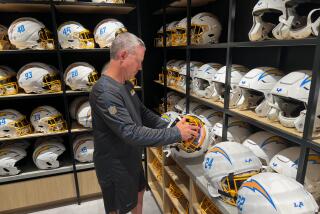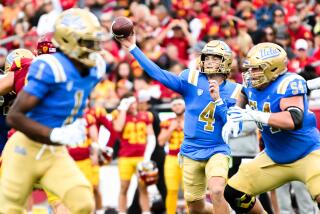Screening Tackles Health Problems of NFL Players
- Share via
Mike Sherrard had no reason to think he was in anything other than excellent health. The 42-year-old was still lean and fit, even after eight bruising seasons as a wide receiver in the National Football League. With three years as the average stint for an NFL player, Sherrard saw himself as lucky to have had a long career to walk away from without limping.
But when the former UCLA star heard about the recent sudden deaths of several former NFL players living in California, he was scared into action. “With so many former players dying at a young age, it is a huge wake-up call,” he said Sunday, while waiting to complete a cardiovascular screening in Boyle Heights sponsored by the NFL Players Assn.
The Living Heart Foundation, funded by the players union, put about 60 active and former players through comprehensive testing over the weekend as part of a three-year study to explore the relationship between professional football players and unexpected death, particularly undetected cardiovascular disease.
“We know that body mass is a major factor in heart disease, and we know that football players are often very large people,” said Archie Roberts, a cardiac surgeon and founder of the Living Heart Foundation. Roberts, a former NFL quarterback, said data collected from about 700 players will be forwarded to the Mayo Clinic in Minnesota for analysis. That information, Roberts said, will be compiled into the first-ever medically based report examining the rate of cardiovascular disease among professional football players -- a relationship that anecdotal evidence has suggested is quite strong.
The most obvious risk factor is body weight. In a sport in which it is not uncommon for offensive and defensive lineman to weigh 300 pounds or more, physicians say that unless players entering retirement are educated about maintaining a proper diet and continuing to be physically active, they become susceptible to high blood pressure, high cholesterol, hypertension, heart attacks and strokes.
Roberts said a condition called “athlete’s heart,” in which the heart muscle is enlarged and thickened, puts many football players at risk for a sudden heart attack. Thomas Herrion, 23, a 330-pound lineman for the San Francisco 49ers, collapsed after a preseason game last year and died of a heart attack.
“When I was playing, a big guy was 250 pounds. That’s obviously different now,” said Ed Marinaro, a former All-American running back at Cornell University and runner-up for the Heisman Trophy in 1971. He had a six-year career in the NFL. “My generation was old school. We would eat steak and eggs before a game, thinking we needed all that protein. Think of what that does to your heart.
“It’s different now -- there is a lot of information. If young players don’t know how to take care of themselves, they have their heads in the sand.”
Marinaro, 56, has been an actor for more than 25 years and says he’s careful about his diet. Still, he’s beginning to feel the cumulative effects of football collisions and the eat-all-you-can mentality.
“Guys I played with died recently. It’s scary,” he said, adding that he was notified about the screening sessions by a letter from the local chapter of the NFL Players Assn. “At my age, I’m concerned about my health. I don’t think it’s good for the sport to get a letter that tells me I’m at risk of dying when I’m in my 50s.”
Like many former players, Bob Zeman expected his biggest concerns after his playing days were over would be orthopedic; he’s had two shoulder surgeries and four knee surgeries. But Zeman, a defensive back who retired in 1966 and went on to coach the Oakland Raiders, said he’s taking medications to control his blood pressure and cholesterol.
“I think this program is awesome; it’s great they are doing this,” Zeman said. “I’ve had friends who have had heart attacks and strokes, some of my good friends. We need to figure out what to do.”
While the study’s results will guide much of the future approach to aftercare for former players, the key to preventing cardiovascular problems is educating current players, said Alan Levy, team physician for the New York Giants. He said the team was among the first in the NFL to hire a nutritionist.
“If I tell a player to lose weight, he won’t -- he knows he’ll lose his job,” Levy said of the linemen. “We focus on teaching them proper diet and how to eat properly when they leave the NFL.” Levy said a related health problem for bigger players is sleep apnea, which often occurs among players with necks larger than 17 inches around. Testing for the condition was included in the weekend’s screening, in part a response to a study that found 34% of the league’s linemen had some form of sleep apnea.
Levy said sleep apnea occurs when a player is sleeping and his neck muscles relax. The weight of the muscles collapses the trachea, cutting off oxygen to the brain. The sleeping player will momentarily wake up and change position, but Levy said the condition carries potentially serious effects, including hypertension and stroke. The sudden death of former Green Bay Packer defensive end Reggie White in his sleep last January was attributed in part to sleep apnea.
More to Read
Go beyond the scoreboard
Get the latest on L.A.'s teams in the daily Sports Report newsletter.
You may occasionally receive promotional content from the Los Angeles Times.











